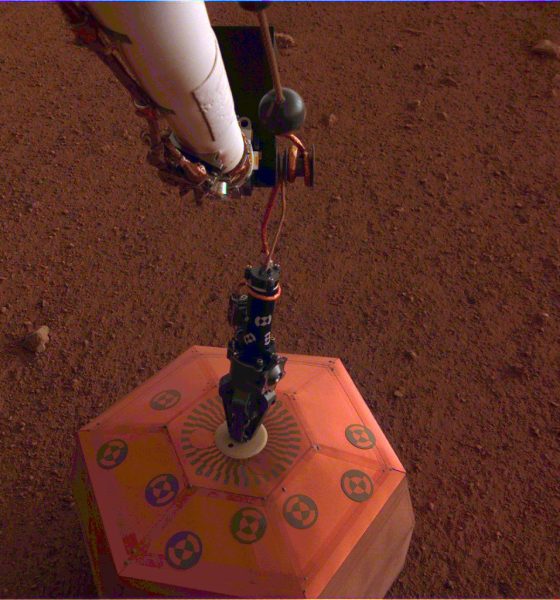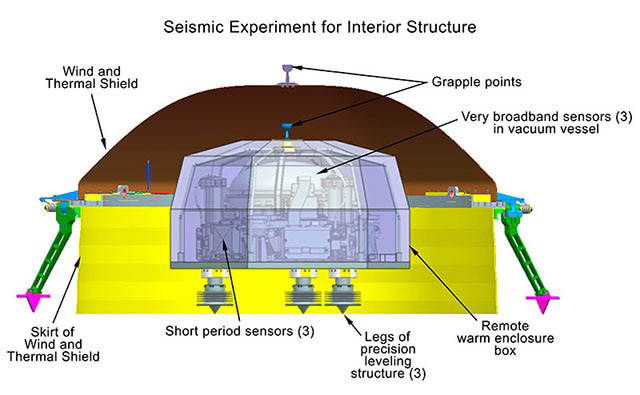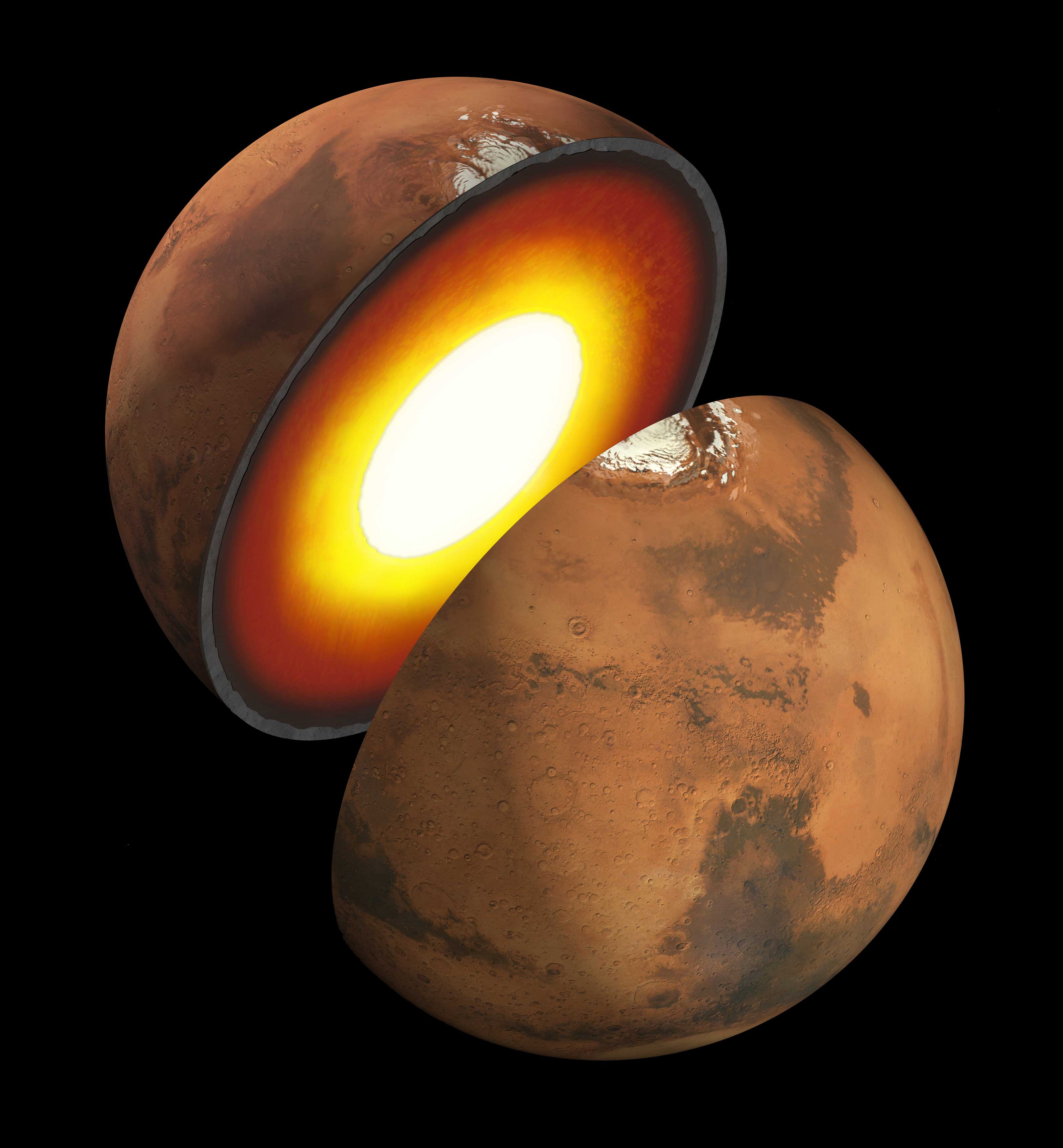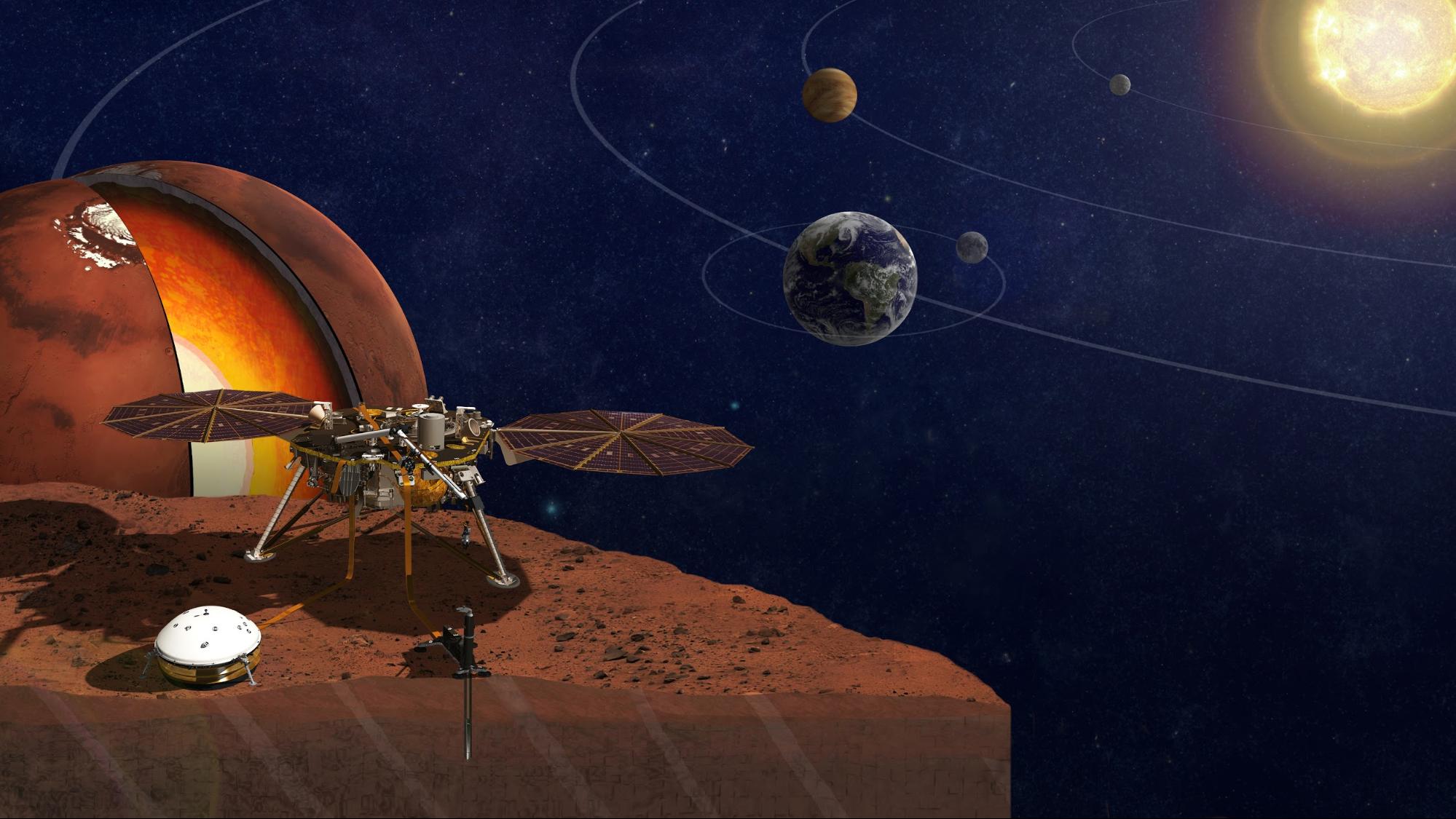

News
NASA’s InSight hopes to detect “marsquakes”, deploys seismometer on Mars
In another historic feat for NASA’s InSight lander, a seismometer has now been deployed on Mars, marking the first time a scientific instrument has been placed onto the surface of another planet. Once the craft’s team have things set up for readings, its instruments will begin measuring the internal vibrations of the red planet, hoping to ultimately learn about the activities and composition of its core and crust. InSight’s instruments will also study how powerful and frequent seismic activity is on Mars along with how often the surface is hit with meteorites. If we’re hoping to explore and possibly live there one day, this is all very important information to have.
After launching on May 5, 2018, aboard an Atlas rocket in California, InSight and its MarCO twin CubeSat companions traveled through deep space for around 6 months before landing on the Martian surface at 11:52 PST on November 26, 2018, an event watched live around the world, including a broadcast in Times Square, New York City. The planned mission for the craft is a little over 1 Martian year, i.e., about 2 Earth years, during which time it will aim to provide scientific data useful for understanding the processes that have shaped the rocky planets of our solar system. In other words, the things InSight learns about Mars will be directly relevant to our own planet as well.
InSight’s name is actually an acronym for “Interior Exploration using Seismic Investigations, Geodesy and Heat Transport”, each part being a reference to the specific science it will be conducting. There are several auxiliary instruments on board the lander that will assist or complement its main mission. However, there are 3 scientific instruments on the craft to help meet its objectives.


First, a seismometer named the Seismic Experiment for Interior Structure (SEIS) will study seismic waves from the Martian surface to study the planet’s crust. When magma moves or meteorites hit, the instrument will detect the motion and gather information that will tell scientists about Mars’ temperature, pressure, and composition. This is the instrument featured in the lander’s recent photo.
Second, a heat flow probe named the Heat Flow and Physical Properties Probe (HP3) will burrow more than 10 feet into the surface to measure the heat still flowing out of Mars, giving clues about how it evolved and whether Earth and Mars are made of the same materials. Finally, a radio science instrument named the Rotation and Interior Structure Experiment (RISE) will measure tiny changes in the location of InSight to measure Mars’ “wobbles” on its axis. This movement data will provide information about the planet’s core.


InSight is conducting its experiments on the western side of the Elysium Planitia of Mars, a smooth, flat region near the planet’s equator. The location was chosen from a pool of 22 candidate landing sites, all within Elysium, evaluated during several workshops from 2013-2015. The decision was made based on Elysium’s proximity to the equator (maximum sun for InSight’s solar arrays), low elevation (plenty of atmospheric space for its landing), lack of rocks and slopes (flat enough for the instruments to deploy and work properly), and the subsurface structure (so the digging instruments could burrow easily).
Next, InSight will finish setting up its remaining instruments and begin its full science mission. We can expect to continue receiving image updates from the lander as more milestones are reached. Here’s an extra bonus if you want to feel like you’re “there” with InSight: NASA’s “Experience InSight” interactive web page lets you control a virtual version of the lander in a Martian environment. You can deploy its solar panels, move around a few of its instruments, or just learn about the various parts that make up the mission. There are additionally two virtual cameras, just like the ones onboard the actual craft, enabling you to watch the movements you’re making, just like InSight’s team sees from their control center.
Watch the below video for a recap of InSight’s landing:

Elon Musk
Elon Musk’s X will start using a Tesla-like software update strategy
The initiative seems designed to accelerate updates to the social media platform, while maintaining maximum transparency.

Elon Musk’s social media platform X will adopt a Tesla-esque approach to software updates for its algorithm.
The initiative seems designed to accelerate updates to the social media platform, while maintaining maximum transparency.
X’s updates to its updates
As per Musk in a post on X, the social media company will be making a new algorithm to determine what organic and advertising posts are recommended to users. These updates would then be repeated every four weeks.
“We will make the new 𝕏 algorithm, including all code used to determine what organic and advertising posts are recommended to users, open source in 7 days. This will be repeated every 4 weeks, with comprehensive developer notes, to help you understand what changed,” Musk wrote in his post.
The initiative somewhat mirrors Tesla’s over-the-air update model, where vehicle software is regularly refined and pushed to users with detailed release notes. This should allow users to better understand the details of X’s every update and foster a healthy feedback loop for the social media platform.
xAI and X
X, formerly Twitter, has been acquired by Elon Musk’s artificial intelligence startup, xAI last year. Since then, xAI has seen a rapid rise in valuation. Following the company’s the company’s upsized $20 billion Series E funding round, estimates now suggest that xAI is worth tens about $230 to $235 billion. That’s several times larger than Tesla when Elon Musk received his controversial 2018 CEO Performance Award.
As per xAI, the Series E funding round attracted a diverse group of investors, including Valor Equity Partners, Stepstone Group, Fidelity Management & Research Company, Qatar Investment Authority, MGX, and Baron Capital Group, among others. Strategic partners NVIDIA and Cisco Investments also continued support for building the world’s largest GPU clusters.
News
Tesla FSD Supervised wins MotorTrend’s Best Driver Assistance Award
The decision marks a notable reversal for the publication from prior years, with judges citing major real-world improvements that pushed Tesla’s latest FSD software ahead of every competing ADAS system.

Tesla’s Full Self-Driving (Supervised) system has been named the best driver-assistance technology on the market, earning top honors at the 2026 MotorTrend Best Tech Awards.
The decision marks a notable reversal for the publication from prior years, with judges citing major real-world improvements that pushed Tesla’s latest FSD software ahead of every competing ADAS system. And it wasn’t even close.
MotorTrend reverses course
MotorTrend awarded Tesla FSD (Supervised) its 2026 Best Tech Driver Assistance title after extensive testing of the latest v14 software. The publication acknowledged that it had previously criticized earlier versions of FSD for erratic behavior and near-miss incidents, ultimately favoring rivals such as GM’s Super Cruise in earlier evaluations.
According to MotorTrend, the newest iteration of FSD resolved many of those shortcomings. Testers said v14 showed far smoother behavior in complex urban scenarios, including unprotected left turns, traffic circles, emergency vehicles, and dense city streets. While the system still requires constant driver supervision, judges concluded that no other advanced driver-assistance system currently matches its breadth of capability.
Unlike rival systems that rely on combinations of cameras, radar, lidar, and mapped highways, Tesla’s FSD operates using a camera-only approach and is capable of driving on city streets, rural roads, and freeways. MotorTrend stated that pure utility, the ability to handle nearly all road types, ultimately separated FSD from competitors like Ford BlueCruise, GM Super Cruise, and BMW’s Highway Assistant.
High cost and high capability
MotorTrend also addressed FSD’s pricing, which remains significantly higher than rival systems. Tesla currently charges $8,000 for a one-time purchase or $99 per month for a subscription, compared with far lower upfront and subscription costs from other automakers. The publication noted that the premium is justified given FSD’s unmatched scope and continuous software evolution.
Safety remained a central focus of the evaluation. While testers reported collision-free operation over thousands of miles, they noted ongoing concerns around FSD’s configurable driving modes, including options that allow aggressive driving and speeds beyond posted limits. MotorTrend emphasized that, like all Level 2 systems, FSD still depends on a fully attentive human driver at all times.
Despite those caveats, the publication concluded that Tesla’s rapid software progress fundamentally reshaped the competitive landscape. For drivers seeking the most capable hands-on driver-assistance system available today, MotorTrend concluded Tesla FSD (Supervised) now stands alone at the top.
News
Elon Musk’s Grokipedia surges to 5.6M articles, almost 79% of English Wikipedia
The explosive growth marks a major milestone for the AI-powered online encyclopedia, which was launched by Elon Musk’s xAI just months ago.

Elon Musk’s Grokipedia has grown to an impressive 5,615,201 articles as of today, closing in on 79% of the English Wikipedia’s current total of 7,119,376 articles.
The explosive growth marks a major milestone for the AI-powered online encyclopedia, which was launched by Elon Musk’s xAI just months ago. Needless to say, it would only be a matter of time before Grokipedia exceeds English Wikipedia in sheer volume.
Grokipedia’s rapid growth
xAI’s vision for Grokipedia emphasizes neutrality, while Grok’s reasoning capabilities allow for fast drafting and fact-checking. When Elon Musk announced the initiative in late September 2025, he noted that Grokipedia would be an improvement to Wikipedia because it would be designed to avoid bias.
At the time, Musk noted that Grokipedia “is a necessary step towards the xAI goal of understanding the Universe.”
Grokipedia was launched in late October, and while xAI was careful to list it only as Version 0.1 at the time, the online encyclopedia immediately earned praise. Wikipedia co-founder Larry Sanger highlighted the project’s innovative approach, noting how it leverages AI to fill knowledge gaps and enable rapid updates. Netizens also observed how Grokipedia tends to present articles in a more objective manner compared to Wikipedia, which is edited by humans.
Elon Musk’s ambitious plans
With 5,615,201 total articles, Grokipedia has now grown to almost 79% of English Wikipedia’s article base. This is incredibly quick, though Grokipedia remains text-only for now. xAI, for its part, has now updated the online encyclopedia’s iteration to v0.2.
Elon Musk has shared bold ideas for Grokipedia, including sending a record of the entire knowledge base to space as part of xAI’s mission to preserve and expand human understanding. At some point, Musk stated that Grokipedia will be renamed to Encyclopedia Galactica, and it will be sent to the cosmos.
“When Grokipedia is good enough (long way to go), we will change the name to Encyclopedia Galactica. It will be an open source distillation of all knowledge, including audio, images and video. Join xAI to help build the sci-fi version of the Library of Alexandria!” Musk wrote, adding in a later post that “Copies will be etched in stone and sent to the Moon, Mars and beyond. This time, it will not be lost.”








